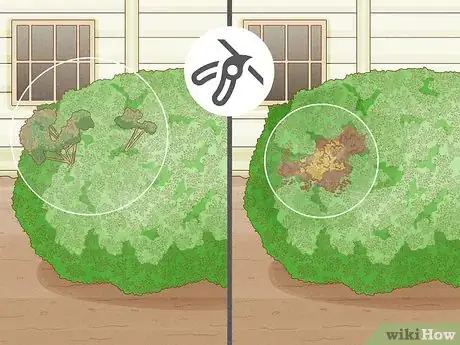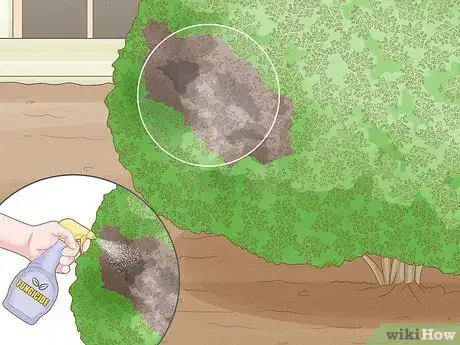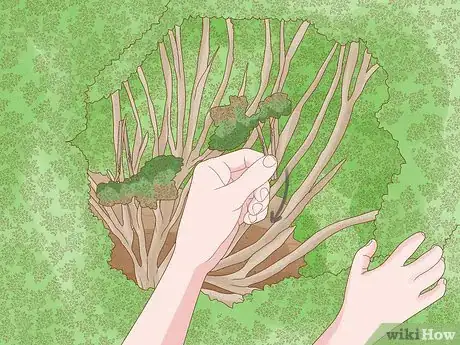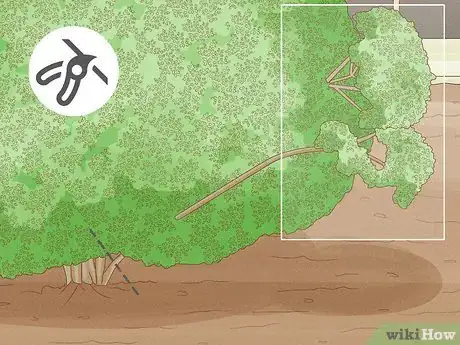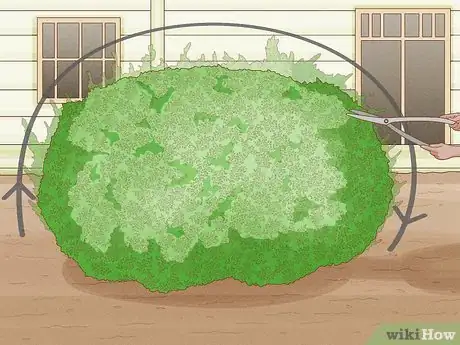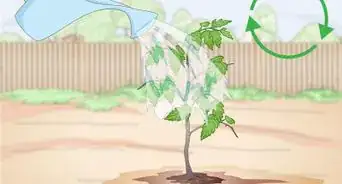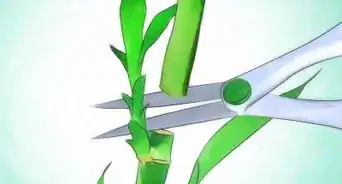This article was co-authored by Lauren Kurtz. Lauren Kurtz is a Naturalist and Horticultural Specialist. Lauren has worked for Aurora, Colorado managing the Water-Wise Garden at Aurora Municipal Center for the Water Conservation Department. She earned a BA in Environmental and Sustainability Studies from Western Michigan University in 2014.
wikiHow marks an article as reader-approved once it receives enough positive feedback. In this case, 87% of readers who voted found the article helpful, earning it our reader-approved status.
This article has been viewed 116,880 times.
Boxwoods are hardy, durable shrubs. If your boxwood has become overgrown, all you'll need is a pair of sharp, clean pruning shears or loppers. Before shaping the shrub, make sure you remove all of the dead or damaged sections of the plant. Thinning boxwoods so that air and light can reach the middle of the shrub is the most important thing you can do, as they tend to become very thick.
Steps
Removing Dead or Damaged Foliage
-
1Remove dead or damaged branches from the shrub first. These branches should be easy to spot—the leaves will be shriveled up and brown, and the stems will snap easily. Use sharp, clean pruning shears to snip off the dead sections, making the cut at the base of the branch.[1]
- Make sure you look at the interior of the shrub for dead or damaged sections, not just the outer parts of the shrub.
-
2Watch out for signs of boxwood blight. If your branches are diseased, you might see brown spots on the leaves or leaves that are almost entirely brown. Look for black cankers on stems as well. If you see boxwood blight, try using fungicides to help control the disease, change the soil around the shrub, or try putting down mulch to stop the spread of the disease.
- Fungicides are usually applied directly to the plant, either remaining on the surface or being absorbed into the plant.
- Make sure you read the instructions on the fungicide carefully to ensure you're applying the right amount to the plant and following proper safety protocol. [2]
- If your boxwood blight is serious, do a quick search online to find the best strategy for fixing your shrubs.
Advertisement -
3Remove any plant debris that accumulates in the center of the shrub. Use your hands to separate the uppermost branches, allowing you to see inside of the shrub. If there are any leaves that have fallen off of branches or branches that have snapped off and are stuck in other branches, remove all of the debris from the plant with your hands.[3]
- Removing leaves and branches that have fallen off will allow more light and air to reach the middle of the shrub.
Cutting Back the Shrub
-
1Thin the plant to allow more light and air to reach the middle. Look for particularly bulky sets of leaves and branches or branches that should be shortened, and follow these down to the main branch. You should be cutting as far down as you see greenery using pruning shears, making a cut at the base of a branch if possible.[4]
- To cut down as far as you see greenery, look at the branch and see where the leaves are growing on it. Only cut as far down as the greenery is growing.
- Overgrown boxwoods become super thick, not allowing light or air to reach the middle of the shrub, which results in an unhealthy plant.
- On boxwoods that have not been trimmed in several years, decrease the size of the shrub over many growing seasons. Only cut ⅓ of the total shrub so it stays healthy.
-
2Trim off branches that are sticking out above the shrub. This will help tame the shrub while also making the boxwood look better for the viewer. Use pruning shears to clip off stray taller branches so that the shrub is level and rounded.[5]
- Many times, the stems sticking out will be new growth showing lighter green colored leaves.
-
3Prune the whole plant, not just the tops that are easily accessible. Instead of focusing on making the outer layer of the shrub look its best, pull aside the branches of the boxwood to look inside. Make sure you’re pruning branches that you can’t easily see as well as the ones that you can.[6]
-
4Use loppers if the growth of your boxwoods are out of control. If your boxwoods have grown an incredible amount and a simple pruning won’t suffice, get a pair of pruning loppers. Cut back the main limbs so that they’re at a reasonable height, and work on maintaining the rounded shape of the bush.[7]
- In this case, some of your branches may be leafless when you cut them back.
- Remember not to cut off more than one-third of the shrub each growing season.
- Pruning loppers have a longer handle and are great for more heavy-duty pruning.
Community Q&A
-
QuestionCut no more than 1/3 each season. Does that mean one foot if the diameter of the bush is three feet?
 Community AnswerIt means to trim no more than 1/3 the height, regardless of the diameter. I just did this with an upright variety of boxwood which I trim in a cone shape from the bottom up to help it keep its shape. My daughter has smaller variety of boxwoods and cuts them all summer to keep them at the height she likes.
Community AnswerIt means to trim no more than 1/3 the height, regardless of the diameter. I just did this with an upright variety of boxwood which I trim in a cone shape from the bottom up to help it keep its shape. My daughter has smaller variety of boxwoods and cuts them all summer to keep them at the height she likes.
Things You'll Need
- Pruning shears
- Pruning loppers (optional)
- Gardening gloves
- Fungicide (optional)
- Soil (optional)
- Mulch (optional)
Warnings
- Never remove more than one-third of the plant at a time.⧼thumbs_response⧽
References
- ↑ https://www.youtube.com/watch?v=2U46_6bvkIA
- ↑ https://www.youtube.com/watch?v=2U46_6bvkIA
- ↑ https://www.southernliving.com/garden/grumpy-gardener/pruning-big-boxwoods-when-how
- ↑ https://www.youtube.com/watch?v=2U46_6bvkIA
- ↑ https://www.youtube.com/watch?v=2U46_6bvkIA
- ↑ http://www.thepruningschool.com/Articles/boxwoodPruning.htm
- ↑ https://www.southernliving.com/garden/grumpy-gardener/pruning-big-boxwoods-when-how
About This Article
If your boxwood shrubs are getting overgrown, first trim away any dead or damaged branches. Use a pair of sharp, clean cutting shears and make your cuts at the base of the branch. If you notice any leaves or stems with brown or black discolorations on them, your boxwood may have a fungal infection called boxwood blight. Apply a fungicide according to the directions on the package. Gently part the branches of the shrub and remove any debris that’s fallen inside, such as dead leaves or broken branches. Next, look for especially thick or overgrown branches and thin them out. Follow the branch you want to remove all the way down to its base and trim it off with a pair of sharp shears. This will help create better air circulation in the middle of the plant. Make sure you don’t cut away more than 1/3 of the total number of branches. Once you’ve thinned out the bush to your liking, use a pair of loppers to cut away any straggly ends that are sticking out beyond the main part of the bush. Go over the whole shrub and trim it into a neat, rounded shape. For tips on how to cope with boxwood blight, keep reading!
